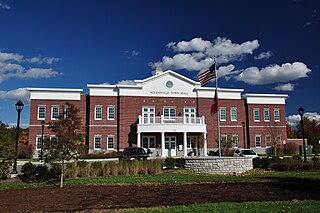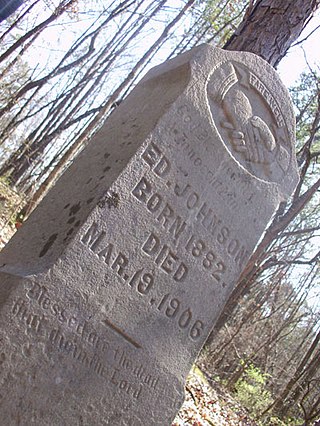Related Research Articles

Williamson County is a county in the U.S. state of Tennessee. As of the 2020 United States census, the population was 247,726. The county seat is Franklin, and the county is located in Middle Tennessee. The county is named after Hugh Williamson, a North Carolina politician who signed the U.S. Constitution. Williamson County is part of the Nashville-Davidson–Murfreesboro–Franklin, TN Metropolitan Statistical Area. In the 19th century, tobacco and hemp were cultivated here, and planters also raised blooded livestock, including horses and cattle.

Nolensville is a town in Williamson County, Tennessee. Its population was 13,829 at the 2020 census. It was established in 1797 by William Nolen, a veteran of the American Revolutionary War. Located in Middle Tennessee, it is about 22 miles southeast of Nashville. The town was reincorporated in 1996.

Goodlettsville is a city in Davidson and Sumner counties, Tennessee. Goodlettsville was incorporated as a city in 1958 with a population of just over 3,000 residents; in 2020 the population was 17,789.

Fisk University is a private historically black liberal arts college in Nashville, Tennessee. It was founded in 1866 and its 40-acre (16 ha) campus is a historic district listed on the National Register of Historic Places.

Edward Ward Carmack was an attorney, newspaperman, and political figure who served as a U.S. Senator from Tennessee from 1901 to 1907.

Hang 'Em High is a 1968 American DeLuxe Color revisionist Western film directed by Ted Post and written by Leonard Freeman and Mel Goldberg. It stars Clint Eastwood as Jed Cooper, an innocent man who survives a lynching; Inger Stevens as a widow who helps him; Ed Begley as the leader of the gang that lynched Cooper; and Pat Hingle as the federal judge who hires him as a Deputy U.S. Marshal.

The Episcopal Diocese of Tennessee is the diocese of the Episcopal Church in the United States of America that covers roughly Middle Tennessee. A single diocese spanned the entire state until 1982, when the Episcopal Diocese of West Tennessee was created; the Diocese of Tennessee was again split in 1985 when the Episcopal Diocese of East Tennessee was formed. It is headquartered in Nashville, Tennessee.
On May 16, 1918, a plantation owner was murdered, prompting a manhunt which resulted in a series of lynchings in May 1918 in southern Georgia, United States. White people killed at least 13 black people during the next two weeks. Among those killed were Hazel "Hayes" Turner and his wife, Mary Turner. Hayes was killed on May 18, and the next day, his pregnant wife Mary was strung up by her feet, doused with gasoline and oil then set on fire. Mary's unborn child was cut from her abdomen and stomped to death. Her body was then repeatedly shot. No one was ever convicted of her lynching.

On March 19, 1906, Ed Johnson, a young African American man, was murdered by a lynch mob in his home town of Chattanooga, Tennessee. He had been sentenced to death for the rape of Nevada Taylor, but Justice John Marshall Harlan of the United States Supreme Court had issued a stay of execution. To prevent delay or avoidance of execution, a mob broke into the jail where Johnson was held, and abducted and lynched him from the Walnut Street Bridge.
Triune is an unincorporated community in eastern Williamson County, Tennessee, approximately halfway between Franklin and Murfreesboro. The community is located along the Wilson Branch of the Harpeth River. The intersection of former local roads State Route 96 and the concurrency of U.S. Routes 31A and 41A is here. The community is located just north of these roads interchange with Interstate 840.

The Knoxville riot of 1919 was a race riot that took place in the American city of Knoxville, Tennessee, on August 30–31, 1919. The riot began when a lynch mob stormed the county jail in search of Maurice Mays, a biracial man who had been accused of murdering a white woman. Unable to find Mays, the rioters looted the jail and fought a pitched gun battle with the residents of a predominantly black neighborhood. The Tennessee National Guard, which at one point fired two machine guns indiscriminately into this neighborhood, eventually dispersed the rioters. Headlines in the immediate aftermath stated five people were killed, while the Washington Times reported "Scores dead." Other newspapers placed the death toll at just two, though eyewitness accounts suggest it was much higher.
Samuel A. Bierfield is believed to be the first Jew lynched in the United States. Bierfield and his African-American clerk, Lawrence Bowman, were confronted in Bierfield's store in Franklin, Tennessee, and fatally shot on August 15, 1868, by a group of masked men. The killers were believed to belong to a local chapter of the Ku Klux Klan, which had emerged as an insurgent force in the state in 1866. Bierfield's murder was reported by both The New York Times and the Nashville Union and Dispatch.
Colonel Edmund William Cole was an American Confederate veteran and businessman. He was the president of the Nashville, Chattanooga and St. Louis Railway, and the founder of the American National Bank.
Samuel "Mingo Jack" Johnson was an African American man falsely accused of rape. He was brutally beaten and hanged by a mob of white men in Eatontown, New Jersey.
Ephraim Grizzard and Henry Grizzard were African-American brothers who were lynched in Middle Tennessee in April 1892 as suspects in the assaults on two white sisters. Henry Grizzard was hanged by a white mob on April 24 near the house of the young women in Goodlettsville, Tennessee.
David Jones was an African-American man who was lynched in Nashville, Tennessee on March 25, 1872 after being arrested as a suspect in a killing. He was mortally wounded while in jail, shot twice in the back while resisting white mob members who came to take him out; the whites pulled him into the Public Square and hanged him from a post outside the police station, with a crowd of an estimated 2,000 in attendance. The sheriff interrupted the hanging and took Jones down. Taken back to the jail, Jones died of his injuries on April 9, 1872.
Jim Taylor was an African-American man who was lynched on April 30, 1891 in Franklin, Tennessee.
Jo Reed was an African American man who was lynched in Nashville, Tennessee, on April 30, 1875, where he was taken by a white mob from the county jail after being arrested for killing a police officer in a confrontation. He was hanged from a suspension bridge but, after the rope broke, Reed survived the attempted lynching, escaped via the river, and left Nashville to go West.

John Henry Harrison was a 38-year-old African-American man who was lynched in Malvern, Hot Spring County, Arkansas, by masked men on February 2, 1922. According to the United States Senate Committee on the Judiciary it was the 10th of 61 lynchings in America and 1 of 5 lynchings in the State of Arkansas during 1922.
References
- 1 2 3 4 5 6 7 8 9 10 11 12 13 14 15 16 "Mob Lynches Negro Boy Who Shot Grocer. Body of Masked Men Take Him From Hospital. Samuel Smith, 15, Left Hanging Near Home of Ike Eastwood, Whom He Wounded Friday Night" . Nashville Tennessean. December 16, 1924. pp. 1, 5. Retrieved May 2, 2018– via Newspapers.com.
- 1 2 3 4 5 "$5,000 Reward for Arrest of Mob Offered. Civic Clubs Denounce Lynching of Samuel Smith, Negro Who Shot Grocer. To Uphold Law. Ike Eastwood In Hospital Learns First of Lynching From Reporter" . The Tennessean. December 17, 1924. pp. 1, 5 – via Newspapers.com.
- 1 2 "The Nashville Lynching" . The Leaf-Chronicle. Clarksville, Tennessee. December 17, 1924. p. 4. Retrieved May 8, 2018– via Newspapers.com.
- ↑ Deane, Natasha (June 5, 2017). "Memorial Marker for Lynching Victims". St Anselm Episcopal Church. Retrieved April 27, 2018.
- 1 2 3 Confehr, Clint (June 15, 2017). "Lynching Victims Memorialized". Tennessee Tribune. Retrieved May 3, 2018.
- ↑ Scheu, Katherine (June 7, 2017). "Nashville's Episcopal Church remembers 1892 lynchings in city". The Tennessean. Retrieved April 26, 2018.